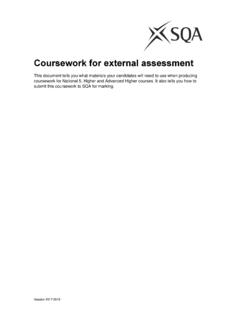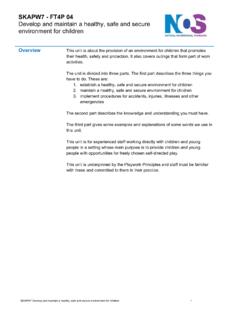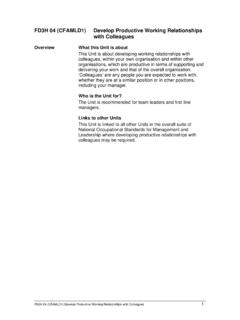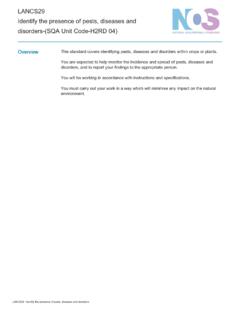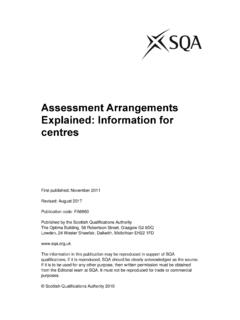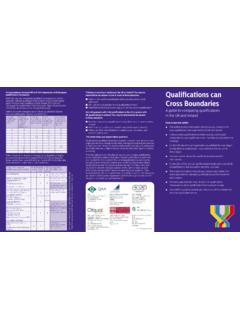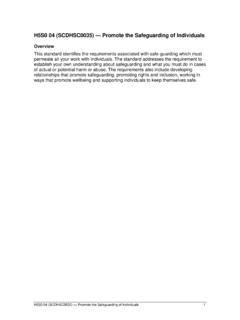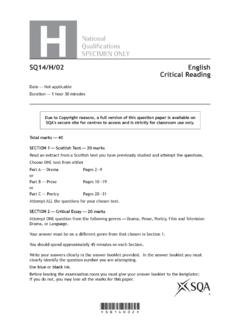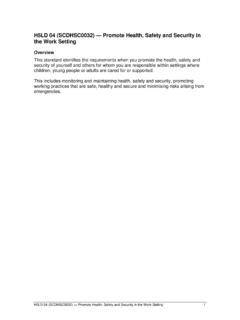Transcription of National Courses: guidance on gathering evidence and ...
1 National Courses: guidance on evidence for estimates in session 2021 22. This edition: October 2021, version Publication code: BB8283. Published by the Scottish Qualifications Authority The Optima Building, 58 Robertson Street, Glasgow G2 8DQ. Lowden, 24 Wester Shawfair, Dalkeith, Midlothian EH22 1FD. The information in this publication may be reproduced in support of SQA qualifications. If it is reproduced, SQA should be clearly acknowledged as the source. If it is to be used for any other purpose, then written permission must be obtained from It must not be reproduced for trade or commercial purposes. Scottish Qualifications Authority 2021. SQA is committed to using plain English. We will try to make our publications as easy and straightforward to understand as we can, and will try to avoid all unnecessary jargon.
2 If there's any language in this document that you feel is hard to understand, or could be improved, please write to Editor, Editorial Team, at the Glasgow address or email: Contents Introduction 1. What are estimates and how are they used? 1. Understanding course assessment requirements and standards 1. Estimates and fairness for learners 2. Bias 3. Reviewing evidence to produce an estimate 3. Determining the weight to be placed on different sources of learner evidence 4. Type, quantity, and quality of evidence 5. Professional judgement 6. Relative and absolute attainment 7. Arriving at the final band estimate 8. National 5, Higher and Advanced Higher bands 8. Moderating estimates 8. Scenario planning for session 2021 22 9. Further information and support 10. Introduction This document provides guidance to SQA co-ordinators, department/curriculum leaders, teachers and lecturers in SQA approved centres on using assessment evidence to support an estimate, and on determining the appropriate grade and band to estimate for a learner.
3 In any year, estimates play an important role in SQA awarding processes. They should be submitted for National 5, Higher and Advanced Higher course entries in accordance with the key dates. We publish key dates each year on SQA. Connect. For this session, if the SQA examination diet is cancelled, the assessment evidence used to determine estimates will also be used as the basis for generating provisional results. There are no additional assessment requirements in determining provisional results over and above those that support learning and subsequently determine estimates, in a normal year. We will publish procedural information on submitting estimates to SQA in Delivering National Qualifications: Guide for SQA Co-ordinators 2021 22. What are estimates and how are they used? An estimate is a judgement of a final grade and band for a graded National Course across all assessment components.
4 It is based on a holistic review of a learner's performance as indicated by assessment evidence that is generated at the centre. It is important that each estimate is a realistic, evidence -based prediction of a learner's final attainment in the course assessment. We will use estimates to: help to prioritise learners' scripts for re-consideration during the finalisation stage of awarding procedures check that awarding outcomes are as fair as possible to learners support the interpretation of evidence for Exceptional Circumstances Consideration requests Estimates are considered by SQA examiners as part of the evidence review for learners for whom an Exceptional Circumstances Consideration request is made. Learners must have had an estimate submitted to be able to access the Exceptional Circumstances Consideration Service.
5 Understanding course assessment requirements and standards To make accurate estimates, it is important to have a clear understanding of: the range of skills, knowledge and understanding covered by the course 1. the assessment requirements and the structure of the course the components that contribute to the course award, including weightings where appropriate the grade descriptions for the course the level of demand of the course assessment Information on these aspects is available for each course from the course specification, specimen question papers, past papers, coursework assessment tasks and Understanding Standards materials. The course specifications for National Courses give detailed information on the purpose of each course component. This includes the mandatory skills, knowledge and understanding that each component assesses, and the structure and broad mark allocations for each component.
6 Please note that for session 2021 22 the assessment requirements for National Courses have been modified in response to the COVID-19 pandemic. Please read the National Course modification summary, which outlines the changes and final requirements for this session, in conjunction with the course specification. You can find these for each National Course on the subject pages of our website, under Course Information 2021 22'. SQA's Understanding Standards resource also provides examples of candidate responses, with commentaries, for most National Courses. This provides a useful benchmark of the level of demand in the subject and can help support teachers and lecturers make accurate assessment judgements. Estimates and fairness for learners There may be a range of factors that impact on learners' access to learning.
7 When determining estimates, it is important to bear this in mind, especially in the following cases: Where illness, other personal circumstances, or barriers to learning might have affected a learner's performance in an assessment, a review of their performance in alternative assessments of appropriate demand will ensure fairness. For learners who have assessment arrangements, or who would have reasonable adjustments, it is appropriate to reflect on whether support was in place, or whether the assessment was used as a baseline' indicator for future support. Estimates must be based on demonstrated attainment with the reasonable adjustments/assessment arrangements in place. Some learners may have their learning supported by peripatetic teachers or support for learning specialists. You may want to include these staff in your estimate discussions.
8 2. Bias Any discussion of fairness must take account of the possibility of bias. Decisions about a learner's estimate should be based on the learner's evidence rather than their personal circumstances, so that decisions are as objective and as consistent as possible. Special mention must be made of what might be called implicit bias'. Implicit bias originates from assumptions or stereotypes based on characteristics such as social background, gender, disability, race and ethnicity. Research strongly suggests that implicit bias may be a contributing factor in assessment judgements, which is why SQA's e- marking procedures include the suppression of candidates' personal data. You, too, should consider how to mitigate the risk of bias when in determining estimates for a group of learners. Learners' evidence should be valued for its own worth and merit as an indicator of course attainment, and you should make a conscious effort to consider and avoid the negative impact of potential implicit bias.
9 You should finalise estimates by considering the accuracy of your decisions alongside information on background, gender, disability, race and ethnicity, at both class and cohort presentation level. Use of blind- or cross- marking can decrease the potential for bias in grading decisions, and moderation across departments and faculties should ensure that all learners are treated fairly and that robust standards are maintained. It is important to remember the implications of the estimated and actual result for each learner. Every award carries weight and significance personally, socially, educationally, and economically. In other words, a grade or an award has a meaning for the learner but also a meaning and a value in the wider world. For this reason, it is crucial that all learners are treated fairly and equitably.
10 Reviewing evidence to produce an estimate An estimate should reflect the learner's demonstrated attainment of the skills, knowledge, and understanding required for the grade and band. Reviewing a range of evidence will help you to build up a picture of the learner's performance as a whole, which will then enable you to determine an estimate. A starting point to determining estimates should be reviewing the evidence for each learner. Look for instances where learners have applied their learning, or particular aspects of it. This might be at previously identified, planned checkpoints in teaching and learning programmes. These checkpoints might be planned events (eg prelims or mock question papers, assignments, performances) or they might occur naturally. Learners might reach appropriate assessment points at different stages in their learning.
